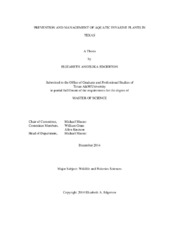| dc.description.abstract | Determining which non-native aquatic plants have the greatest potential to invade a new area and prohibiting those species prior to their introduction is the key to preventing future injurious invasions. Once introduced however, prioritization and effective control is important to managing infestations. This study focused on identifying potential new aquatic invasive plant species and prioritizing existing infestations in Texas, via two aquatic plant models.
An aquatic plant risk assessment was the first model. While other risk assessments of this type currently exist, a model suited to the varied environmental conditions in the State of Texas was not available. In addition, many existing models cover large geographic areas, leading to decreased accuracy on a more localized scale. This new model, referred to as the Texas Aquatic Plant Risk Assessment, was based on previous aquatic plant risk assessment and serves as a pre-entry screening tool for testing non-native plant species and identifying those which are likely to be invasive and should therefore be excluded. The model uses a series of weighted questions to give a score to each plant species tested; the higher the score, the more likely the plant is to be invasive in the State of Texas. We tested the model against 100 known non-native species within the state and subsequently ran a series of statistical tests on the results to determine the model’s accuracy and find the best threshold to separate major invaders from minor and non-invaders. When model results were compared to known species invasiveness and a threshold of 50 was set between high risk major invaders and non-invaders, 100%, 87%, and 94% accuracy was achieved in classifying major invaders, minor invaders, and non-invaders, respectively. Other, more precautionary thresholds were also explored during analysis.
The second model, the Lake Conroe Invasion Model, simulates growth and senescence of hydrilla in Lake Conroe, and the plant’s response to control efforts using grass carp (Ctenopharyngodon idella). The model was developed using reported data from previous hydrilla infestations and control attempts at Lake Conroe, and serves as a prototype for future simulated invasion modeling. A series of simulations were run to calibrate the model, based on previously reported data, and to demonstrate the model’s use. Results from the simulations accurately reflected reported growth and senescence rates of hydrilla within the lake; growth rates for grass carp in the model were also comparable to rates reported in the literature. Simulations of various management strategies showed that increasing numbers of grass carp were needed to control a hydrilla infestation as the time lag between initial hydrilla invasion and stocking of grass carp increased. However, the number of grass carp needed to control an infestation decreased as the amount of time allowed for control increased. In addition grass carp mortality rates may be significantly impacted by grass carp stocking rates relative to the number of vegetated hectares. If smaller stocking rates are preferred in order to avoid removing all aquatic vegetation from the lake, higher mortality rates likely need to be accounted for as increased mortality due to a decreased predator to prey ratio may occur. | en |


